11 Most Amazing Astronomy Stories of 2011
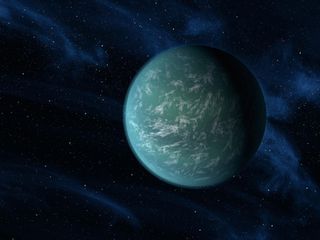
What a year it has been for science and astronomy.
From the discoveries of potentially habitable alien planets to the detection of a tiny new moon around Pluto and jaw-dropping lunar and solar eclipses, astronomical research in 2011 has not only made extraordinary strides but also raised new and tantalizing questions for the future.
"It has been an incredible year for science," Ralph McNutt, a planetary scientist at Johns Hopkins University's Applied Physics Laboratory, told SPACE.com. "All one can hope is that we will keep the appropriate institutions in place so the following years will be as incredible, if not more so."
McNutt is a project scientist for NASA's Messenger mission to Mercury. He is also a co-investigator on the New Horizons mission to Pluto, in addition to being involved in the Cassini mission at Saturn and the twin Voyager spacecraft at the edge of the solar system.
McNutt recently spoke with SPACE.com about some of the most significant astronomical events and findings of the year. In no particular order, here are the 11 best astronomy stories of 2011:

1. Alien Planets in the Habitable Zone
This year proved to be a bounty for exoplanet research. In its first 16 months of operation, NASA's planet-hunting Kepler spacecraft detected 2,326 potential alien worlds.
Get the Space.com Newsletter
Breaking space news, the latest updates on rocket launches, skywatching events and more!
"You can have all kinds of expectations and make all kinds of predictions, but making predictions versus actually finding stuff is a huge difference," McNutt said. "So, given the fact that they've been making these identifications and being able to confirm them, I think the team is just overjoyed and happy beyond their wildest dreams. Kepler has just been an incredibly good investment of research dollars for the United States of America."
Earlier this month, the observatory confirmed the discovery of its first alien planet in the habitable zone of its parent star. This so-called habitable zone is located at just the right distances away from the star so that conditions could allow liquid water to exist on a planet's surface.
"This is a huge advance," McNutt said. "The surprise has been that the solar system we live in is not necessarily a good template. We're seeing other systems that are all over the map, so that in itself is interesting. This is really a huge step for us to start to fill in what we know about the universe around us."
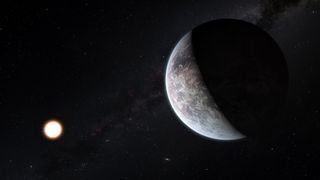
But Kepler is not alone in its hunt for alien worlds.
A telescope from the European Southern Observatory that searches for signs of exoplanets also made enticing finds this year. The High Accuracy Radial velocity Planet Searcher instrument, or HARPS, found more than 50 new alien planets, including one super-Earth that could potentially support life.
As researchers continue to sift through data from Kepler, HARPS and various other instruments, exoplanet research is not showing any sign of slowing down.
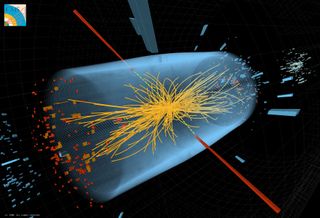
2. Scientists Closing in on the Higgs Boson Particle
Researchers at the European Organization for Nuclear Research (CERN) in Geneva, Switzerland, announced Dec. 13 they had made significant progress in their search for the Higgs boson particle.
Also known as the "God particle," the Higgs boson is thought to be tied to a field that is responsible for giving all other particles their mass. In a much-hyped announcement, scientists at CERN's Large Hadron Collider said they now are able to narrow down the Higgs' mass, which represents an important step in their hunt for the elusive particle. [Top 5 Implications of Finding the Higgs Boson]
"It's going to be very interesting to see what becomes of this," McNutt said. "It would be very surprising if, in the process, we don't come up with new questions. This is really a new chapter in a very interesting mystery novel."
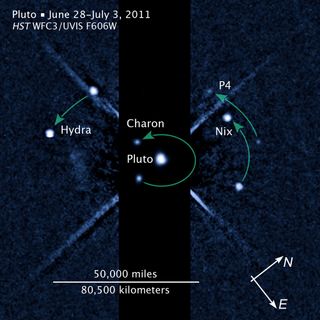
3. Pluto's New Moon
In July, it was announced that a tiny new moon had been discovered around the dwarf planet Pluto. A survey conducted by the Hubble Space Telescope found the moon, which is the fourth and smallest one yet found circling Pluto.
"It's symptomatic of the fact that there's this huge world out there that we don't know yet," McNutt said. "When I was growing up, I was the ultimate geek and space cadet. I knew all the names of the planets and I knew how many moons they all had. At the time, Saturn had nine moons, Uranus had five, Neptune had two, and Pluto didn't have any. That's been rewritten multiple times now, and it gets back to the idea that part of science, and part of understanding the world we live in, is casting our net wider and looking at new things."
The moon, which has temporarily been named P4, is estimated to be 8-to-21-miles (13-to-34-kilometers) wide. Pluto's largest moon, Charon, is 648-miles (1,043-km) wide, and the two others, Nix and Hydra, range from 20-to-70-miles (32-to-113-km) across.
The New Horizons probe is currently journeying out into the solar system and is scheduled to fly through the Pluto system in 2015. The mission is designed to provide new insights about worlds at the edge of our solar system.
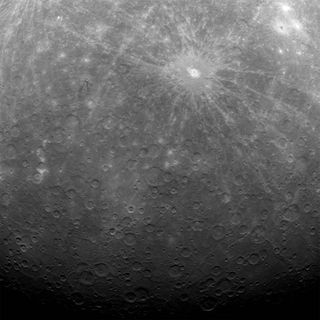
4. Messenger Probe Becomes First to Orbit Mercury
After six-and-a-half years of traveling in space, NASA's Messenger probe made history March 17 by becoming the first spacecraft to enter into orbit around Mercury.
"One of the things I like to say about Mercury is from one of the Star Trek episodes about 'the undiscovered country,'" McNutt said. "With Mercury, we certainly had our first tantalizing glimpses with Mariner 10. Now we've gone back and gone into orbit. We've really been able to map the planet and know what it looks like. We're seeing these incredible volcanic formations from a long time back in the history of the solar system. We're trying to figure out how to put together the pieces of the puzzle."
The Messenger mission (short for Mercury Surface, Space Environment, Geochemistry and Ranging) is designed to study and map Mercury's surface in unprecedented detail. The probe will also investigate the planet's composition, magnetic field, geologic history and its mysteriously thin and tenuous atmosphere.
"We've literally rewritten the book on the innermost planets of the solar system, and it's an important book to rewrite. It's been a question of having a highly motivated group of people and the right technology and the right kind of situation and the right program to pull all these pieces together so you can actually accomplish it. It really has been a tremendous accomplishment."

5. Dark Energy Physicists Win Nobel Prize
Three astrophysicists won the Nobel Prize in physics this year for their discovery that the universe is not only expanding, but accelerating as well.
Saul Perlmutter of Lawrence Berkeley National Laboratory and the University of California, Berkeley; Brian Schmidt of the Australian National University and Adam Riess of Johns Hopkins University and the Space Telescope Science Institute snagged the prestigious honor for their groundbreaking work that led to the enigmatic concept of dark energy.
To explain how the universe's expansion is accelerating, the scientists came up with a mysterious force, "dark energy," that is working against the gravitational forces that are pulling the universe inward. While dark energy has yet to be directly detected, it is thought to make up 73 percent of all mass and energy in the universe. [7 Surprising Things About the Universe]
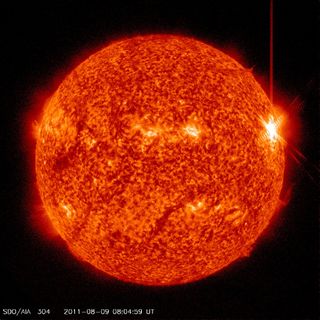
6. The Sun Wakes Up
After a long quiescence, 2011 saw an increase in solar activity. In August, an extremely powerful solar flare was unleashed from the sun. In fact, the X-class flare was the largest one in over four years, scientists said.
Solar activity waxes and wanes on a roughly 11-year cycle. The current cycle began in 2008 and is expected to last until 2020. After a period of more subdued behavior, the sun is now ramping up toward a solar maximum in 2013.
Scientists are particularly interested in studying the sun and how space weather affects our planet. Solar flares and coronal mass ejections can trigger stunning auroras on Earth, but violent sun storms can also carry negative effects. Solar plasma that is ejected by powerful X-class eruptions has the potential to damage satellites in space and wreak havoc on power systems and other infrastructure on Earth. [Sun's Wrath: Worst Solar Storms in History]

7. Comet Elenin and the Great Nbiriu Hoax
When the icy comet Elenin swung through the inner solar system in September, it set off a firestorm among conspiracy theorists and doomsayers. NASA scientists repeatedly assured the public that the comet flyby posed no threat, but some people latched onto the idea that Elenin was a harbinger of doom.
The infamous object made waves on the Internet, when doomsayers claimed that comet Elenin's pass through the inner solar system would spell disaster for our planet. Some insisted the comet would disrupt Earth's gravity and trigger catastrophic earthquakes. Others proclaimed that Elenin was not a comet but a rogue planet called Nibiru that would destroy Earth.
In the end, comet Elenin broke apart when it flew near the sun in September, and NASA scientists officially pronounced it dead mid-October. Still, the sensation among die-hard doomsayers was enough to vault this relatively weak comet into infamy.
"This sort of thing with comets has gone on for a long time," McNutt said. "Every so often, there is this whole thing about comets as being purveyors of doom, and historically it goes back a long way. Halley's Comet was seen in England during the Battle of Hastings in 1066, when William the Conqueror conquered England. So, depending on which army you were on, I suppose it could have been a purveyor of success or a purveyor of defeat."

8. Fantastic Lunar and Solar Eclipses
This year, lucky skywatchers were treated to two lunar eclipses and four solar eclipses.
On June 15, the moon was tinted red during the longest total eclipse in 11 years. A total lunar eclipse occurs when the Earth passes between the sun and the moon, casting the moon completely in shadow.
The second and final lunar eclipse of the year took place Dec. 10. Skywatchers in western Canada and the United States, as well as Alaska, Hawaii, Australia, New Zealand and central and eastern Asia caught glimpses of a stunning celestial show as the moon appeared inflated and bright red. The next total lunar eclipse will not occur until 2014.

Several weeks before, a partial solar eclipse darkened the sun over parts of the southern hemisphere, as the moon slid between Earth and the sun for the fourth and final time of the year. The Nov. 25 eclipse was visible in southern South Africa, Antarctica, Tasmania and most of New Zealand, according to scientists.
"I've actually seen several lunar eclipses and they're certainly interesting, but two things that everybody on the planet needs to have the chance to do is: see a total solar eclipse and see a rocket take off from one of the spaceports," McNutt said. "Trying to see this stuff on film and TV does not do it justice.
The next solar eclipse, May 20, 2012, is expected to be a stunning event, and will be visible from China, Japan and parts of the United States. During this so-called annular solar eclipse, the moon will cover a large portion (but not all) of the sun.
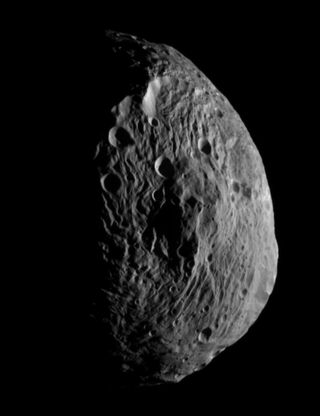
9. Asteroids, Oh My!
Asteroids have always been major astronomical players, but several found themselves sharing the spotlight this year.
After launching in 2007, NASA's Dawn spacecraft arrived at the asteroid Vesta in July to kick off a yearlong study of the giant space rock. Since its arrival, Dawn has already beamed back some of the clearest views yet of the huge, battered asteroid, including images of massive depressions and a huge mountain inside an expansive crater.
Vesta is the second-most-massive object in the main asteroid belt between Mars and Jupiter. After spending a year at Vesta, Dawn will travel to the asteroid Ceres, which is the largest body in the main asteroid belt.

But Vesta wasn't the only asteroid to make headlines in 2011.
An asteroid the size of a city block, called 2005 YU55, zipped past Earth in a rare flyby that marked the closest such a large asteroid has come to our planet in 35 years. The space rock passed within the orbit of the moon Nov. 8 before speeding off into deep space.
The asteroid was never in danger of hitting Earth, but it did provide researchers with an unprecedented opportunity to learn more about 2005 YU55 and its orbit.

10. Gains Made in Search for Killer Space Rocks
In September, a NASA study was released that found fewer potentially dangerous asteroids orbiting Earth than was previously thought. The discovery significantly lowered the number of medium-size asteroids near Earth to 19,500, which represented nearly a 50-percent drop from initial estimates.
The study's findings suggested that the threat to Earth by dangerous asteroids may also be somewhat less than previously thought. But scientists also said thousands more of these asteroids remain to be found. [Photos: Asteroids in Deep Space]
"There was a large asteroid impact that really rewrote the whole structure of life on this planet," McNutt said. "It happened once, it might happen again. Getting a close look at these objects is so important because there are a lot of pieces of that puzzle that we still haven't put together. By trying to find out their nature and where they've been, it will help us figure out how the solar system was put together."

11. Ongoing Search for Alien Life
In early March, a study published in the Journal of Cosmology ignited a controversy over the possible detection of alien life in meteorites.
Astrobiologist Richard Hoover of NASA's Marshall Space Flight Center in Huntsvilla, Ala., used scanning electron microscopes to analyze slices of carbonaceous meteorites that fell to Earth from space. In his study, Hoover claimed to have detected "filaments" and other features that resemble microbes in the meteorites.
The study was quickly criticized by other scientists, who discredited the research and said that the findings did not amount to convincing evidence.
"Extraordinary claims require extraordinary proof," McNutt said. "In science, many extraordinary claims don't work out, but occasionally some of the extraordinary things are extraordinarily right. That's one of the reasons you go look. If we're looking at whether there was a second genesis in the solar system, something similar to what happened on Earth several billion years ago, Mars is a good place to look."

In fact, recent discoveries on Mars are helping to paint a clearer picture of whether conditions on the Red Planet are, or ever have been, suitable to support microbial life.
On Dec. 7, scientists presented findings from the Mars rover, Opportunity, that were the best evidence yet that water flowed on the planet long ago. Opportunity discovered a thin, bright mineral vein along the rim of the huge Endeavour crater. According to scientists, the mineral is almost certainly gypsum that was deposited by liquid water billions of years ago.
NASA launched its newest mission, the Mars Science Laboratory (MSL), to the Red Planet Nov. 26. When the car-size rover Curiosity touches down on Mars in August, it will likely help researchers gain a better understanding of the planet and its environment.
"There are a lot of question marks, but certainly MSL, when it gets down in August, will give us more insights into that," McNutt said.
You can follow SPACE.com staff writer Denise Chow on Twitter @denisechow. Follow SPACE.com for the latest in space science and exploration news on Twitter @Spacedotcom and on Facebook.
Join our Space Forums to keep talking space on the latest missions, night sky and more! And if you have a news tip, correction or comment, let us know at: community@space.com.

Denise Chow is a former Space.com staff writer who then worked as assistant managing editor at Live Science before moving to NBC News as a science reporter, where she focuses on general science and climate change. She spent two years with Space.com, writing about rocket launches and covering NASA's final three space shuttle missions, before joining the Live Science team in 2013. A Canadian transplant, Denise has a bachelor's degree from the University of Toronto, and a master's degree in journalism from New York University. At NBC News, Denise covers general science and climate change.
